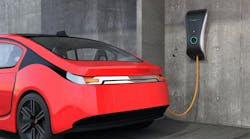LightFair International 2013 was a hit at the Philadelphia Convention Center and drew more than 23,000 attendees from April 21-25.
Seen everywhere on the show floor, solid-state lighting is becoming the preferred light source faster than expected. Attracting the most attention at the show was a wide gamut of new LED products from retrofit lamps to innovative new fixture designs fitted with digital control systems that provide dimming and color-changingfeatures.
The ability of LED chips to deliver the exact color and luminance level desired by an occupant, and the ability of a wired network, a wireless control network, a hybrid of the two, or a power-line control scheme to control them, are the solid-state technologies most responsible for establishing LEDs in many different niches of the lighting market.
On the communications front, I believe short-range wireless communication will dominate the field, because it allows LED lighting to be set up with a simplified plug-and-play activity. The latest versions of sensors, analytic integrated chips and refined controls will help make this happen.
Other lighting trends apparent on the show floor were daylight harvesting; bi-level control; wider choices in power switching; distributed intelligent control; simplified programming for quicker start-up; and easier integration with a building monitoring system. All of these features and technologies revolve around energy savings.
Several vendors showed lighting products using WiFi-based communications features since it’s an international standard with encryption that’s universally trusted. Acuity Brands, Atlanta, displayed WiFi control for many of its fixtures, and Samsung showed a starter kit using wireless ZigBee-based retrofit lamps. Samsung is seeking an entry point into the networked home using devices such as smartphones, occupancy sensors, internet-enabled TV, appliances, air conditioning systems, security systems and door locks.
Vendors also showed roadway and other outdoor LED luminaires fitted with occupancy sensors and wireless network capability that can capture and transmit information from the surrounding environment for a variety of applications and services, such as public safety, weather monitoring, parking management and retail analytics.
Retrofit kits that replace the guts of existing T12, T8 and T5 recessed fluorescent troffers, or downlights with an LED source were seen throughout the show. Leviton showed its expanded Zipline modular fluorescent retrofit kit with integrated prewired driver and LED strips that adhere to the fixture housing. Max Lite’s RKT series recessed troffer retrofit kit is a similar product. Other exhibitors displayed products that replaced high-wattage HID parking and roadway fixture with LED solutions and high-density mesh (HDM) wireless control systems.
The convergence of the light source and the controls that serve the source allow for new luminaire forms tailored to each visual task. Increasingly, LED luminaires are taking advantage of being pinpoint light sources by using edge-lit thin profile flat panels to distribute the light evenly over the entire panel surface, while achieving up to 95% efficiency.
Philips’ Bold Play suspended and wall mounted luminaires use MesoOptics and light guide technology. Cooper Lighting’s Metalux Encounter recessed ceiling luminaire uses its Wave-Stream flat panel (edge lit technology) which eliminates LED pixilation and the need for diffusers. And GE showed products using this technology with its line of blade-thin, edge-lit Lumination EL Series LED suspended luminaires.
While LEDs were the darlings of the show, attendees did not overlook the improved performance of other sources, such as fluorescent and metal-halide lamps and ballasts. Electronic fluorescent systems can provide up to 60,000 hour rated life, and Program Rapid Start (PRS) ballasts allow up to 46,000-hour life, on a 12-hour cycle, because of "soft starting" of the lamp. A ceramic metal-halide lamp, coupled with electronic ballasts, can offer savings over halogen with CRI greater than or equal to 95.
LED replacement bulbs have almost become mainstream commodity products, with Cree, Philips and other firms announcing price lists in the $12-$15 range.
Silicones are evolving to meet the growing need of the LED lighting industry regarding the increasing light flux and thermal loads experienced, since moldable silicone can be used in light guides, lenses, diffusers and remote phosphor diffusers. For that reason, Dow Corning — traditionally thought of as an industry chemical company— was an exhibitor this year.
— Joe Knisley in Philadelphia








